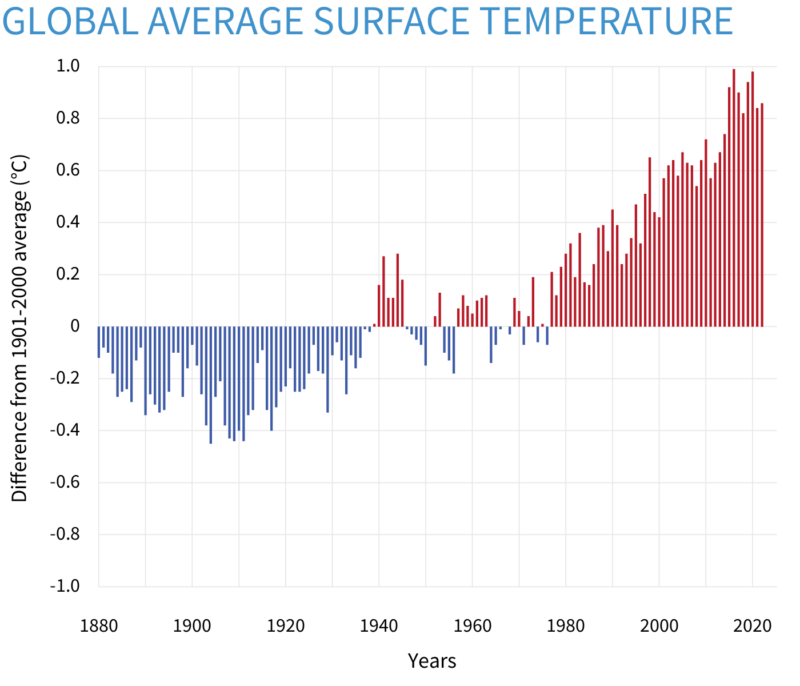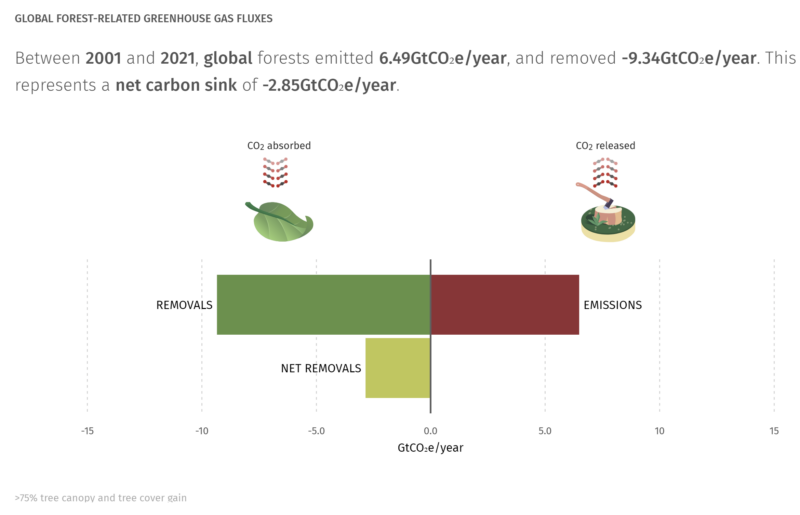Seeing the forest through the trees is an expression you may not think of when the topic of global warming comes up. However, 31% of the earth’s surface is covered by trees and each one is working overtime to sequester carbon to combat global warming.
Carbon sequestration is a natural or artificial process by which carbon dioxide is removed from the atmosphere and held in solid or liquid form. It is estimated that forests absorb approximately 7.6 billion metric tons of carbon annually9.
The Rise of Global Temperatures

Climate.gov
More intense storms, rising ocean levels, extreme temperatures, species loss, food insecurities, health risks, and other climate changes are the result of global warming1.
The National Oceanic and Atmospheric Administration has data on average global surface temperatures dating back to 1880 (Figure 1) . Since that time, temperatures have been consistently rising, and in the last 40 years temperatures have been increasing two-fold per decade since 19816. An increase of just one degree may not seem like a lot, however, even small increases in the earth’s temperature can have major impacts, such as:
Species loss – extinction is now a threat to almost one million animals and plants globally4.
Coral Reefs – as Ocean temperatures continue to rise there is increased disease, coral bleaching, and ocean acidification6.
Forest Fires – although fires can rejuvenate forests and are natural, global warming is resulting in longer fire seasons, larger areas affected, and increased frequency of fires7.
Extreme weather events – hurricanes, rain, droughts, flooding, and heat wave frequency and severity is increasing8.
Greenhouse Gas Emissions
Human activities, mainly energy consumption, are contributing to our global temperature rise as more and more greenhouse gases (GHG) are being released into the atmosphere2. Carbon dioxide (CO2), methane, nitrous oxide and fluorinated gases are the main greenhouse gases that contribute to global warming, with CO2, a gas that absorbs and radiates heat, being the most abundant and outweighing the others combined2. Data released by the World Resources Institute from 2019 illustrated Global CHG Emissions (See Figure 2)3.
In total, human activities contributed to almost 38 gigatons of CO2 emissions in 2019 compared to just under 27 gigatons twenty years prior. It is in response to these emissions and their effects on global temperature that the 196 parties came together to sign the Paris Agreement. The agreement is aimed to reduce global warming to an aggressive target of below two degrees Celsius12. Recently the United Nations climate office indicated this goal is far from being met.
“We are still nowhere near the scale and pace of emission reductions required to put us on track to-ward a 1.5 degrees Celsius world,” says Simon Stiell, the head of the U.N. climate office.10
In fact, according to the Greenhouse Gas Bulletin produced by the World Meteorological Organization, in 2021 there have been record numbers of all GHG emissions globally with the growth rate of Methane causing the biggest concern11.
“WMO’s Greenhouse Gas Bulletin has underlined, once again, the enormous challenge – and the vital necessity – of urgent action to cut greenhouse gas emissions and prevent global temperatures rising even further in the future,” said WMO Secretary-General Prof. Petteri Taalas.
Forests and Global Warming

globalforestwatch.org
In 2021, the United Nations published The Global Forest Goals Report shining a light on the importance of forests to our climate and humans from water quality to medicines to the air we breathe. Simply put, through the process of photosynthesis, trees absorb carbon dioxide from the atmosphere and store it in both above- and below-ground biomass. This process of capturing carbon dioxide from the atmosphere is referred to as Carbon Sequestration. With over three trillion trees,14 our global forests reduce the amount of greenhouse gases, the same ones that cause global warming, in the atmosphere.
On the flip side, forests also release carbon into the atmosphere through deforestation, fires, and tree death (Figure 3). Unfortunately, through human activity and climate change, these events have become more frequent and more severe. Currently, forests have an annual net absorption of carbon at just over seven gigatons – or about 18% of the CO2 emissions released into the atmosphere compared to 26% in 2002 – a decrease of 8% in terms of offsetting emissions.
The question becomes, with the current rate of deforestation – there are approximately 46% less trees on earth now than the start of civilization15 and it is estimated 15 billion trees are cut down and not replaced annually14 – and with the increase in severity of weather events, are our forests able to do their part to slow climate change?
Measuring Forests’ Benefits
For some time, emission data has been presented grouped by regions. Now, Global Forest Watch improved the analysis of land emissions and produced updated maps that better illustrate the current state of our forests and the carbon fluxes they produce. carbon fluxes from forests. The maps detail everything from tree cover, tree cover loss, cover loss due to fires, burned areas, GHG emissions, GHG net flux, biomass density, soil carbon density, and more. As tools like these become more widely available, so will more reliable data as to the benefits of our forests on climate change – allowing better planning to protect not only the earth’s forests, but earth as well.
*References can be found here.
